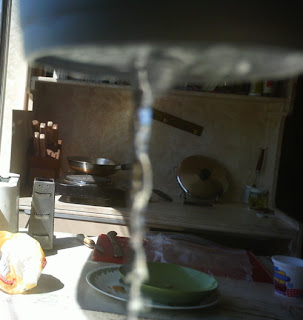- You'll Need: red and blue food coloring, 1-3/8 cup cornstarch, 2/3 cup water, bowl, spoon
- Measure the water and add some food coloring (3 drops of each color) to make the water purple.
- Measure 1 cup of the cornstarch into a bowl. Slowly add the water, stirring to mix well. I let K. do this mixing.
- Ours was too diluted to work, so I added 1/8 of a cup of cornstarch at a time, mixing well after each addition. After adding 3/8 cup the solution was perfect.
- Grab a handful of the mixture and form a ball by rolling it between your hands. While rolling the mixture it feels dry.
- Stop rolling and let the mixture rest on your outstretched palm. The ball turns back into an ooze.
- Why? Remind your child of the water and marbles experiment -- the marbles pushed the water out of the way; and the water and salt experiment -- there was room for the salt molecules between the water molecules (a solution). Water and cornstarch are different. The cornstarch molecules are held together by the water. This is called a suspension. When you roll the mixture it squeezes together on all sides and feels dry, but when you stop rolling, the cornstarch particles drift apart and there is your ooze again.
- You'll Need: a jar, water, plastic lid (like from a tub of margarine or sour cream)
- Do the first two steps on Monday
- Fill the jar to the brim with water (we used a glass jar and it broke even though no lid was screwed on) and place the lid on top of the jar.
- Place it in the freezer.
- On Tuesday take it out of the freezer. The ice will have pushed the lid above the top of the jar.
- Why? When water freezes its molecules spread out and need more space. The freezing water molecules pushed out of the jar because they needed more space.
- We had to try this one three times to get it right, but with what I learned, you should be able to get it the first time
- You'll Need: food coloring, small glass jar, saucepan, water, stove
- Put enough water in the saucepan for it to to 1/2 way up the jar.
- Put some food coloring in the jar and fill it about 3/4th of the way full.
- Put the saucepan on the stove, put the jar in the saucepan. Carefully pour water into the jar until it is holding as much water as possible.
- Heat the pan on high.
- When the water in the jar gets hot enough, it overflows into the saucepan.
- Turn the heat off and let it cool. See how much water overflowed (some probably evaporated, too).
- Why? Water molecules need more space when heated, looking for room to spread out, they spill over the top.
My two mistakes were
- I didn't fill the saucepan full enough and before the jar spilled water, it cooled off too much.
- We weren't watching when it spilled.
Thursday we learned what a Water Molecule Does When It Gets Cold.
- You'll Need: a jar, water, freezer, timer
- Fill the jar to the brim with water.
- Place it uncovered in the freezer for 30 minutes
- Observe the level of the water. The level of the water had dropped below the rim of the jar.
- Why? As water gets colder (to about 39F) its molecules contract (huddle closer together) so they take up less space in the jar.
Friday we learned about Cohesion.
- You'll Need: a Styrofoam cup, a sharp pencil, water, sink
- With the pencil, poke 2 holes in the bottom of the cup. They should be small and close together, but not touching.
- Fill the cup with water, keep it over the sink. Two distinct streams of water will pour out of the cup.
- Quickly pinch the two streams of water together. You may need to try it a few times before you get it to work right.
- The two streams will become one stream (it worked for me when I pinched them as close to the cup as possible).
- Why? Water molecules are so attracted to each other, that when they get near to other water molecules they grab onto each other and stick together. This sticking-together action is called cohesion.





No comments:
Post a Comment